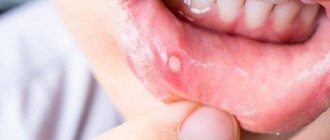Have questions?
Herpetic or herpes stomatitis is an inflammation of the oral mucosa caused by the herpes simplex virus. The disease manifests itself as ulcers in the mouth, headache and even fever.
This type of stomatitis accounts for about 80% of all infectious lesions of the oral cavity. The infection mainly develops in children's bodies, and children under three years of age are most susceptible to it. HIV carriers, diabetics, patients with chronic pathologies and people with weakened immune systems are also at risk.
Causes
Herpetic stomatitis, or as it is also called aphthous stomatitis, is dangerous, first of all, for young children. It is a serious viral disease, which, in addition to damaging the oral mucosa, causes general intoxication of the body and provokes malfunctions of the nervous, immune, and reticuloendothelial systems.
Herpes, which is the causative agent of the disease, may not make itself felt for a long time, although infection usually occurs in early childhood.
When the baby’s immunity is weakened, the herpes virus is activated and begins to multiply, causing an increase in temperature, enlargement of the submandibular lymph nodes, acute inflammation of the mucous membrane, and the formation of bleeding and painful ulcers on its surface.
Main reasons:
- decreased baby's immunity;
- previous infectious diseases;
- lack of vitamins;
- insufficient oral hygiene;
- direct contact with patients with herpes stomatitis.
Infants are more likely to become infected with the herpes virus during childbirth, provided the mother has a herpes infection. In children under one year old and school-age children, the virus is activated against the background of an organism weakened by disease and vitamin deficiency.
2. Causes of stomatitis
We have already talked above about why irritation of the oral mucosa may begin. Now let's dwell on the question of why ulcers and herpes appear. Ulcers.
In fact, the exact causes of stomatitis in the form of ulcers are not known. But many things can contribute to their development. These include certain medications, oral injuries, poor diet, stress, bacteria and viruses, sudden weight loss and the consumption of certain foods - potatoes, citrus fruits, coffee, chocolate, cheese and nuts.
Stomatitis may be associated with a weakened immune system due to colds, flu, changes in the body's hormonal levels, as well as a lack of vitamin B12 and folic acid. Even accidentally biting the inside of your cheek or chewing on a sharp piece of food can cause an oral ulcer.
Ulcers can occur as a result of a genetic predisposition. In this case, it is considered an autoimmune disease. In general, ulcers appear in about 20% of people, but the disease is not contagious.
Visit our Therapy page
Main symptoms and signs of the disease
Acute herpetic stomatitis in children develops gradually and is preceded by an incubation period lasting from two days to 3 weeks.
Early symptoms of the disease are:
- burning in the mouth;
- increased salivation;
- headache, nausea, general weakness;
- increased body temperature;
- enlargement of the submandibular lymph nodes;
- the appearance of bad breath.
«
If the parents do not respond to the first signs, after a few days the mucous membrane becomes covered with multiple rashes. Small painful blisters itch, respond with acute pain to the touch, and when they rupture, a cloudy liquid flows out of them. The rash appears on the baby’s gums, cheeks, tongue, lips, and wings of the nose.
Herpes stomatitis can affect not only a school-age child, but also an infant.
The mild form of the disease can be easily treated at home; in moderate and severe forms, hospitalization of the small patient is indicated.
What is stomatitis
Stomatitis (mucositis) is a disease that is accompanied by damage to soft tissues in the oral cavity.
It can be either an independent disease or a complication of various pathological processes, for example, measles, influenza, scarlet fever, etc. Until recently, stomatitis was considered a childhood disease. Today it is becoming more common in adults too. This trend raises questions about whether stomatitis is transmitted and, if so, how to protect yourself and your child. It all depends on the form of manifestation of the disease
Classification and diagnosis
Herpetic stomatitis is classified both according to the severity of the disease and the characteristics of its course.
According to the characteristics of the course, acute and chronic (recurrent) forms are distinguished. Acute stomatitis is characterized by a sudden onset, pronounced symptoms, and rapid development. Without proper treatment, it quickly becomes chronic and can drag on for years, periodically exacerbating.
Based on the degree of severity, there are mild, moderate, and severe forms.
In mild forms, the following are noted:
- slight increase in body temperature;
- redness, swelling, inflammation of the gums;
- swollen lymph nodes;
- a small number of painful ulcers.
The average degree is characterized by:
- significant increase in body temperature;
- general weakness, nausea, headache;
- inflammation of the oral mucosa;
- the appearance of a blistering rash on the inner surface of the cheeks, gums, tongue, and around the mouth.
The severe form causes:
- temperature rise to a critical level;
- lymphadenitis of the cervical, submandibular lymph nodes;
- a sharp disturbance in general well-being;
- the appearance of severe muscle pain, headache;
- nausea, vomiting;
- multiple rashes that spread to the eyelids, conjunctiva, and perioral area.
Diagnosing the disease is not difficult for an experienced doctor. It is based on an analysis of the main symptoms, the order of clinical manifestations of the disease, the nature, and multiplicity of ulcers.
It is necessary to differentiate herpetic stomatitis from viral stomatitis; for this, in the first few days of the disease, a cytological examination of scrapings from erosions and aphthae should be done.
Examination for herpetic stomatitis
The diagnosis is made based on the clinical manifestations of the disease and the results of laboratory tests. Identification of the virus is carried out by studying blood serum, scrapings from the oral mucosa, and saliva. Sometimes serological tests (ELISA) and PCR are necessary. Herpetic stomatitis requires differentiation from other types of stomatitis, tonsillitis, measles, scarlet fever, gingivitis and other diseases with similar clinical symptoms.
How long does the disease last and how many days is the child contagious?
Depending on the complexity of the form, herpes stomatitis in children lasts from several days to 2-3 weeks. With a mild form, the main symptoms disappear on the third or fourth day, treatment of a moderate form takes one to two weeks. The severe form is the most dangerous; healing lasts for weeks and requires mandatory hospitalization of the baby.
The disease is characterized by a high degree of contagiousness precisely during the period of exacerbation.
The infection is transmitted by airborne droplets (including through kissing), when using shared dishes, cutlery, toys, and hygiene items.
Herpes is contagious and can easily be transferred to healthy parts of your own body.
It is necessary to wash your hands thoroughly after treating the surface affected by the sores with medications to prevent the spread of the virus.
Chronic stomatitis
Recurrent aphthous stomatitis
The development of clinical manifestations of chronic aphthous stomatitis is preceded by a prodromal period, which occurs with discomfort in the oral cavity, low-grade fever, and mild malaise.
Subsequently, against the background of hyperemic mucosa, a primary element is formed - aphtha, which is a superficial round ulcer with a diameter of 3-5 mm, covered with fibrinous plaque surrounded by an edematous bright pink rim. Aphthous rashes are usually multiple; localized in the area of the transitional fold, the lateral surfaces of the tongue, the mucous membrane of the cheeks and lips. Aphthae cause severe pain when eating, brushing teeth, or articulating. The healing period of afts ranges from 7-10 days to 2-4 weeks. Epithelization of ulcers occurs without scarring or with the formation of a gentle scar. Relapses of chronic aphthous stomatitis occur at intervals from several weeks to several months. Frequent exacerbations exhaust patients, causing apathy, sleep disturbances, and cancerophobia.
Depending on the frequency of exacerbations, there are 3 degrees of chronic recurrent aphthous stomatitis: mild (with single aphthae and relapses once every few years), moderate (with relapses 1-3 times a year) and severe (with relapses more than 4 times a year , sometimes monthly).
Vincent's ulcerative necrotizing stomatitis
The course of chronic ulcerative-necrotic stomatitis of Vincent is erased. The main complaints of patients are related to soreness and bleeding of the gums, hypersalivation, and putrid odor from the mouth. In the oral cavity there are areas of congestive hyperemia with ulcerations and necrotic changes in the area of interdental spaces. In advanced cases of necrotizing ulcerative stomatitis, exposed bone may be detected during probing of the gingival margin.
General symptoms are not expressed; the submental and submandibular lymph nodes are compacted, and with a long course of the disease they become a cartilage-like consistency. Chronic ulcerative necrotic stomatitis often develops against the background of ulcerative gingivitis and is combined with lesions of the pharynx - Simanovsky-Plaut-Vincent angina.
Herpetic stomatitis
Exacerbations of chronic herpetic stomatitis usually occur in autumn and spring. The morphological elements of chronic herpetic stomatitis are small bubbles (vesicles), quickly turning into plaque-covered erosions. Bubbles and erosions are localized on the mucous membrane of the tongue, palate, cheeks and lips. Elements of the rash are sharply painful and make eating and speaking difficult. The oral mucosa is inflamed and swollen; salivation is increased.
In mild forms of chronic stomatitis, relapses occur no more than 2 times a year and occur with a few blistering rashes in the oral cavity. Moderate course is characterized by a moderate number of rashes and a frequency of exacerbations from 3 to 6 times a year. Severe herpetic stomatitis is accompanied by frequent (more than 6 times a year) exacerbations and multiple rashes.
Prosthetic stomatitis
Chronic denture stomatitis develops in 40-50% of patients using complete removable dentures. This form of stomatitis occurs with inflammatory changes in the mucous membrane in contact with the prosthesis.
When examining the oral cavity, a sharp diffuse hyperemia of the prosthetic bed is detected. In areas of the mucosa injured by the base of the prosthesis, chronic decubital ulcers can form and local bleeding occurs. Pain in the area of inflammation intensifies when using a denture. Chronic trauma to the mucous membrane can be accompanied by its hyperplasia and the formation of papillomas (traumatic papillomatosis of the oral cavity).
Smokers stomatitis
Usually observed in middle-aged and elderly men with a long history of smoking. With chronic nicotine stomatitis, the oral mucosa becomes bluish-brown in color and becomes covered with a slightly whitish coating. Over time, hyperkeratosis of the palate develops with multiple keratotic papules. These changes give the palate a rough texture that looks like a “cobblestone street.”
With simultaneous damage to the mucous membrane of the tongue, nicotine glossostomatitis occurs. Smokers' stomatitis is a risk factor for oral cancer.
How and with what to treat herpetic stomatitis in children
As Dr. Komarovsky notes, treatment of herpetic stomatitis in children, regardless of age, depends on the severity of the disease, the general condition of the patient’s immune system, and the presence or absence of concomitant diseases.
The main question that interests young parents is which doctor should they contact if they suspect herpetic stomatitis. Both a qualified pediatrician and a dentist can advise the child.
Therapeutic methods include both general and local treatment. Common activities include:
- prescription of antiviral drugs (acyclovir, Zovirax, Herpevir, Virolex);
- taking antipyretic and painkillers (paracetamol, Panadol, Eferalgan, Tylenol);
- prescription of antihistamines (diazolin, claritin, erius, fenistil);
- correction of the immune system (immudon, sodium nucleinate);
- vitamin therapy (vitamin C, ascorutin, multivitamins, B vitamins).
Children of older preschool and school age are recommended to be treated with broad-spectrum antibiotics to avoid possible complications.
For newborns and infants, antibiotic therapy is prescribed only as a last resort, with preference given to local therapy:
- applications of painkillers (solution of lidocaine, trimecaine, pyromecaine);
- treating the baby’s oral cavity with antiseptics (solutions of furatsilin, potassium permanganate, brilliant green, blue);
- Treatment of aphthae with iodine should be avoided, as it causes a burn to the mucous membrane;
- the use of antiviral medications in the form of ointments, lotions, solutions (interferon, acyclovir);
- applying an oil solution of vitamin A, sea buckthorn or rosehip oil, solcoseryl to the mucous membrane of the baby’s mouth).
If the symptoms of the disease do not disappear on the 3-4th day of treatment, but only intensify, the child is indicated for treatment in a hospital setting, otherwise stomatitis will become chronic, from which it is impossible to get rid of it.
Treatment with folk remedies at home
When treating herpes stomatitis in children, it is extremely important to prevent the development of complications and transition to a chronic form. Therefore, all folk remedies are auxiliary in nature and should not replace full treatment.
To strengthen the child's immunity, a decoction of echinacea leaves, ginseng root, and rose hips is well suited.
Rinsing will help relieve itching, burning and pain. For these purposes, you can use decoctions of chamomile flowers, sage, calendula inflorescences, St. John's wort, alder cones, rose petals, and oak bark.
The healing of ulcers and aphthae is facilitated by treating their surface with brilliant green, blue and iodine; they have a drying effect. An alcohol solution of propolis helps well, it relieves the inflammatory process and has an analgesic effect on the oral mucosa. Use with caution to treat small children.
Newborns and infants are recommended to lubricate the inflamed oral mucosa with natural honey. This should be done with extreme caution, since honey is a fairly strong allergen.
Possible complications
Primary infection with herpetic stomatitis is highly treatable. Within 7-10 days, with proper treatment, the child can fully recover. Without appropriate drug therapy, the following complications may develop:
- herpetic keratoconjunctivitis (a dangerous herpetic eye infection that leads to blindness);
- dehydration (due to refusal to eat and drink).
To avoid undesirable consequences, it is necessary to consult a doctor at the first symptoms of the disease, strictly adhere to all instructions, give the baby plenty of fluids, monitor oral hygiene, and wash your hands after each treatment of a surface affected by herpes.
Prevention in children
Preventing infection with the herpes virus is extremely difficult, since 90% of the population are carriers of it. It is important to delay infection as much as possible; the younger the child, the more difficult the disease is to tolerate. It is necessary to avoid contact with people who have an acute herpes virus. From infancy, the baby should be taught to use personal hygiene products, not allowed to drink from someone else’s mug after someone else, or to use used spoons, forks, and plates. You should not kiss someone who has a herpetic sore on their lips.
To prevent herpetic stomatitis, you need to do general strengthening of the child’s immune system, systematically give him B vitamins, multivitamin complexes, and carry out hardening procedures.
3.Herpes
Herpes on the lips
appears due to a virus called herpes simplex virus type 1. Unlike ulcers, herpes is contagious from the moment the herpes blisters rupture until complete recovery. Primary infection often occurs during childhood and can be confused with cold or flu symptoms. Once a person becomes infected with the herpes virus, the virus remains in the body and lies dormant most of the time. But during stress, colds, injuries, hormonal changes, under the influence of sunlight, the virus is activated and herpes appears on the lips.
Herpes tends to appear in the same place. And in addition to infecting other people, the herpes virus can spread to other parts of the infected person's body - the eyes and genitals.
About our clinic Chistye Prudy metro station Medintercom page!










